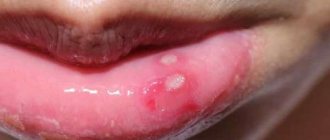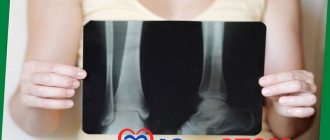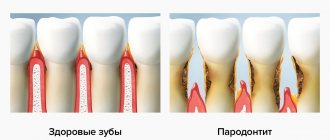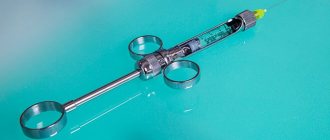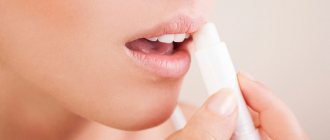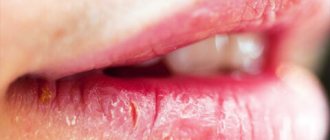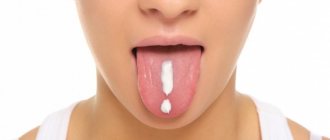Causes of cheilitis
Exposure to adverse weather conditions.
The disease often develops as a result of exposure to unfavorable climatic factors, which include ultraviolet radiation, too low or high air temperature. For this reason, cheilitis often affects people whose work involves regular exposure to fresh air.
Development of an allergic reaction.
One of the reasons for the development of cheilitis is an increase in the sensitivity of the lips to various irritants, mainly of chemical origin.
In this case, the area of the red border of the lips is most often affected and, less often, the mucous membrane. If you do not consult a doctor in a timely manner and do not undergo treatment, the disease can spread to the skin surrounding the lips. Most often, the disease develops due to the use of lipsticks. This is explained by the fact that their composition includes the dye eosin and specific fluorescent substances. The plastic of dentures, aromatic fillers included in toothpastes, etc. can also act as irritants. The disease mainly affects women aged 20-60 years.
Presence of an underlying disease.
Cheilitis on the lips can be a symptom of some disease and manifest itself against the background of neurodermatitis or atopic dermatitis. Eczematous cheilitis is formed with various eczemas, macrocheilitis - with neuritis of the facial nerve in combination with a folded tongue. The most common cause of the disease is dermatoses. The skin of the lips, mucous membrane and red border can also become inflamed with systemic and infectious diseases (psoriasis, tuberculosis, lichen planus, erythematoses, etc.).
Up to contents
Exfoliative
Reason . Depression, anxiety, vegetoneurosis.
Symptoms . It affects only the middle part of the red border of the lips, while at the edges everything remains normal. Accompanied by either itching and peeling, or the development of swelling and abundant crusts. It occurs mainly in women and young girls, especially those suffering from vegetative neurosis. They often have the habit of licking or biting their lower lip.
Treatment and prevention . Complex therapy uses anti-inflammatory and antibacterial ointments, vitamins, and immunomodulators. An important part of treatment is sedatives or tranquilizers. Sometimes psychotherapy is necessary.
Classification of cheilitis
Primary (independent)
- Glandular
This lip disease is caused by acquired or congenital enlargement of the minor salivary glands and their infection. Most often it affects people over 30 years of age. It is worth noting that the upper lip is affected 2 times less often than the lower lip. At the beginning of the development of the disease, patients are concerned about peeling and slight dryness of the lips. If left untreated, pain may occur due to cracks and erosion.
- Exfoliative
This disease affects only the red border of the lips and is accompanied by peeling.
In most cases, women suffer from this disease. In the dry form, scales form on the lips, a feeling of dryness and burning appears; in the exudative form, swelling and abundant crusts form, making it difficult to eat and speak.
- Contact allergic
This disease is caused by a delayed allergic reaction to various irritants upon contact with the red border of the lips. In most cases, this disease affects women over the age of 20. Signs include redness of the lips, swelling, burning and severe itching. With repeated contact with the irritant, the disease worsens. If treatment for cheilitis is not started in a timely manner, the lip becomes covered with small blisters, after which cracks and erosion appear.
- Meteorological
This disease is caused by increased sensitivity to ultraviolet radiation, wind or cold. In most cases, it affects men aged 20 to 60 years. The exudative form is characterized by itching, burning of the lips, and the appearance of erosion. Small bubbles may appear, after opening which crusts form. In the dry form, erythema of the lips is observed, small white-gray scales appear. If left untreated, abrasions and erosion may develop in the future.
Secondary (symptomatic)
- Atopic
It is believed that this type of disease is one of the manifestations of atopic dermatitis. Patients complain of slight swelling of the red border of the lips, while adjacent areas of the skin are involved in the inflammatory process. Also, manifestations of the disease include damage to the corners of the mouth. When acute inflammation begins to subside, the lip begins to peel off. As a result of dryness in the corners of the mouth, cracks form. In the absence of comprehensive treatment, peeling of the facial skin is possible.
- Eczematous
This disease develops against the background of eczema, which results in inflammation of the surface layers of the skin. In the acute stage, patients complain of redness of the lips, burning and itching. In this case, each lip swells, erythema and pathological changes in the skin are observed. If there is no comprehensive treatment, the disease becomes chronic. In this case, acute inflammatory phenomena (hyperemia, edema) decrease, inflammatory infiltration develops, and nodules and scales may form.
- Hypovitaminosis
This disease in most cases develops against the background of hypo- or avitaminosis of group B. Symptoms of cheilitis include burning and dryness of the tongue, lips and oral mucosa. If the disease is not treated, vertical small cracks appear on the red border of the lips, which often bleed. The tongue may increase in size, and teeth marks are often visible on it.
Up to contents
Meteorological
Reason . Exposure to cold air, strong wind. It occurs more often in men, especially those who suffer from general weather sensitivity or work outdoors.
Symptoms . Peeling, itching and dryness, as well as erosions and crusts on the lips. Cracks in the corners of the mouth.
Treatment and prevention. If possible, minimize exposure to cold and wind. Use protective cosmetics for lips. Take B vitamins internally, as well as PP. Use special wound-healing ointments externally and often rinse your mouth with extracts of chamomile, oak bark, and calendula.
Prevention methods
Careful oral hygiene
To prevent the appearance of cracks, you need to protect the skin and mucous membranes from adverse effects. To do this, you should get rid of the habit of licking your lips and corners of your mouth, using medicinal cosmetics for dry skin and hygienic lipsticks. To prevent infection from getting onto the skin of the lips from the oral cavity, it is necessary to brush your teeth at least twice a day, as well as treat caries and inflammatory gum diseases.
Changing your diet
If pockets begin to appear in the corners of the mouth, it is necessary to limit the consumption of spicy, sour and salty foods that irritate the mucous membranes and skin. You can add non-acidic fruits and vegetables to your daily diet, as well as foods containing iron and riboflavin (beef, liver, dairy products, cabbage, potatoes, peanuts, almonds, etc.).
Up to contents
Fungal
Reason . Fungal infection Candida albicans. Damage to the red border of the lips is often combined with stomatitis. The disease is promoted by poor oral hygiene, hypovitaminosis B2, long-term use of antibiotics or glucocorticoids, poor nutrition (little protein foods, too many carbohydrates), as well as carbohydrate metabolism disorders.
Symptoms . The lips are swollen, reddened, the edges of the lips are dry and flaky. In the corners of the mouth there are weeping areas with erosions covered with a whitish, easily removable coating.
Treatment and prevention . First, you need to test for a fungal infection. If its presence is confirmed, the doctor will prescribe antifungal drugs, which should be used orally in combination with vitamin B2 and ascorbic acid. Complete sanitation of the oral cavity and careful treatment of problem areas with oil solutions of vitamins are necessary. To prevent relapses, a diet with limited carbohydrates is prescribed.
Application of METROGYL DENTA®
METROGYL DENTA® is used in the complex treatment of most infectious and inflammatory diseases of the oral cavity, since it has a direct antibacterial effect on pathogenic microorganisms that contribute to the development of inflammation. METROGYL DENTA® does not mask the symptoms of the disease, but helps eliminate the cause of inflammation (pathogenic bacteria). METROGYL DENTA® helps cope with the treatment of cheilitis in adults over 18 years of age.
Up to contents
The information in this article is for reference only and does not replace professional advice from a doctor. To make a diagnosis and prescribe treatment, consult a qualified specialist.
Diagnostics
The cause of the symptom is determined by a dentist or maxillofacial surgeon. If the pain is neuropathic, a consultation with a neurologist is required; if malignant neoplasia is suspected, an examination by an oncologist is required. For cheilitis, herpes simplex and traumatic injuries, the basis of diagnosis is complaints and examination data; additional studies are not prescribed or are carried out to a minimum extent. Neuralgia is confirmed based on the clinical picture and the results of palpation of trigger points. Taking into account the nature of the disease, the examination plan includes:
- Cytological or histological examination.
It is a basic way to verify the diagnosis of lip cancer and lichen planus. For patients with cheilitis, according to indications, it is performed for differentiation from other pathologies. For herpes simplex, it is carried out if it is necessary to identify the virus. - Other laboratory tests.
Patients with cheilitis are prescribed a biochemical blood test to identify metabolic disorders and possible precipitating diseases. For herpes, PCR, RIF, and ELISA are performed. In patients with lichen planus, accumulation of immunoglobulin M is detected by direct immunofluorescence. - Visualization techniques
. The presence of lichen is indicated by a yellowish-orange glow when examining fingerprint smears under a Wood's lamp. Patients with cancer are shown an ultrasound of the lip and radiography of the lower jaw. If there are signs of metastasis, an extensive examination is carried out, including ultrasound of the abdominal cavity, chest X-rays.
Visual inspection of lips
Seagull Lips
• Working with gull lips . It is always difficult to delicately and naturally enlarge gull lips, and it is not always possible to correct the shape at the first correction. It all depends on the anatomical features of the face.
Solution
if you don’t want to change the shape, but just need to swell what you have, you should give preference to small volumes of the drug.
If you need to even out the shape of your lips, then tune in to two, perhaps three corrections with small volumes of the drug. But even after the first procedure, with the right technique and preparation, you can see a decent result. Danger:
Incorrect technique for performing the correction procedure and the wrong density of the drug will give a weak, unnoticeable effect, and sometimes worsen the situation
Pros:
Once the desired effect is achieved, subsequent corrections will be easier; such multi-step work will not be required.
Treatment
Conservative therapy
The list of therapeutic measures is determined taking into account the characteristics of the pathology that causes pain in the lip:
- Cheilitis
. Provoking factors (dental pathologies, meteorological influences, contact with cosmetics) are excluded or minimized, and neurotic disorders are treated. Anti-inflammatory, antipruritic, antiallergic ointments (including hormonal ones), protective creams, immunocorrectors, and general antiviral agents are used. - Herpes
. The tendency to relapse necessitates complex therapy aimed at restoring immunity. Antiviral drugs are used in the first 5-7 days of illness, subsequently immunomodulators and recombinant alpha-interferons are prescribed. After 1-2 months it is recommended to vaccinate. - Lichen planus
. To eliminate inflammation and pain in ulcerative defects, topical corticosteroids, pain relief with local anesthetics, and medications to stimulate regeneration are indicated. To prevent fungal infections during treatment with steroids, antifungal agents are prescribed orally. For neurotic disorders, sedative therapy is required, for allergic predisposition - hyposensitizing therapy, for immunodeficiencies - immunomodulatory therapy. - Injuries
. Patients with chronic damage require treatment of carious teeth to eliminate the traumatic factor. In other cases, in the absence of wounds requiring surgical treatment, a gentle diet, cold to reduce swelling, then dry heat to accelerate resorption are advised. - Trigeminal neuralgia
. Therapy is carried out using anticonvulsants, antispasmodics, and antihistamines. Therapeutic blockades with glucocorticoids and physiotherapeutic procedures are effective: ultraphonophoresis with hydrocortisone, galvanization with novocaine. - Lip cancer
. In stage 1, in some cases, radiotherapy is used as the main treatment method. For patients with advanced stages, radiotherapy and chemotherapy are prescribed in the pre- and postoperative period or carried out as part of palliative treatment.
Surgery
Surgical techniques for pain in the lip are rarely used. Exceptions are open injuries and cancer. For fresh wounds, PSO of the wound of the maxillofacial area is necessary. Neoplasms are excised, and according to indications, a Vanach operation, a Kreill operation, and other interventions involving the removal of regional lymph nodes are performed. For patients with damage to the branches of the trigeminal nerve and persistent neuralgia, methods of stereotactic radiosurgery and percutaneous radiofrequency destruction may be recommended.

